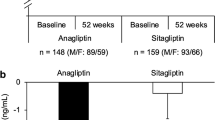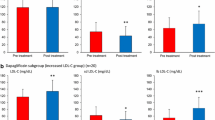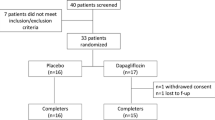Abstract
Aims
Type 2 diabetes (DM2) is associated to oxidative modifications of high-density lipoproteins (HDL), which can interfere with their function. Pioglitazone has proved effective in raising HDL cholesterol (HDL-C) and lowering small dense low-density lipoprotein (LDL), but no clinical studies have examined its effect on lipoprotein oxidation in patients with DM2.
Methods
We assessed the effect of pioglitazone vs glimepiride after 1 year on HDL oxidation, expressed as relative abundance of peptides containing Met112O in ApoA-I (oxApoA-I) estimated by mass spectrometry (MALDI/TOF/TOF), in 95 patients with DM2. The oxLDL and AGE were quantified by ELISA.
Results
Patients receiving pioglitazone showed a significant increase in the concentration of ApoA-I (Δ = 7.2 ± 14.8 mg/dL, p < 0.02) and a reduction in oxApoA-I (Δ = − 1.0 ± 2.6%, p < 0.02); this reduction was not significantly different from glimepiride. oxLDL showed a slight, but not significant increase in both treatment groups. Regression analysis showed a correlation between ΔoxApoA-I and ΔAGE (r = 0.30; p = 0.007) in all patients, while both of these parameters were unrelated to changes in HbA1c, HDL-C, duration of illness, or use of statins.
Conclusions
Long-term treatment with pioglitazone was effective in reducing the oxidation of HDL, but not LDL in patients with DM2, while glimepiride didn’t. This finding seems to be associated to the change of glyco-oxidation status, not to any improvement in glycemic control or lipid profile.
Trial registration
NCT00700856, ClinicalTrials.gov Registered June 18, 2008


Similar content being viewed by others
References
Wilson PW, Abbott RD, Castelli WP (1988) High-density lipoprotein cholesterol and mortality. Framingham Heart Study Arterioscler 8:737–741
Sviridov D, Mukhaedova N, Remaley AT, Chin-Dusting J, Nestel P (2008) Antiatherogenic functionality of high-density lipoprotein: how much versus how good. J Atehroscler Thrombosis 15:52–62
Terasaka N, Wang N, Yvan-Charvet L, Tall AR (2007) High-density lipoprotein protects macrophages from oxidized low-density lipoprotein-induced apoptosis by promoting efflux of 7-ketocholesterol via ABCG1. Proc Natl Acad Sci 104:15093–15098
Van Linkhout S, Spillmann F, Schultheiss H-P, Tschope C (2010) High-density lipoprotein at the interface of type 2 diabetes mellitus and cardiovascular disorders. Curr Pharm Des 16:1504–1516
Daniele G, Guardado Mendoza R, Winnier D, Fiorentino TV, Pengou Z, Cornell J et al (2014) The inflammatory status score including IL-6, TNF-α, osteopontin, fractalkine, MCP-1 and adiponectin underlies whole-body insulin resistance and hyperglycemia in type 2 diabetes mellitus. Acta Diabetol 51(1):123–131
Fiorentino TV, Prioletta A, Zuo P, Folli F (2013) Hyperglycemia-induced oxidative stress and its role in diabetes mellitus related cardiovascular diseases. Curr Pharm Des 19(32):5695–5703
Nobecourt E, Davies MJ, Brown BE, Curtiss LK, Bonnet DJ, Charlton F et al (2007) The impact of glycation on apolipoprotein A-I structure and its ability to activate lecithin:cholesterol acyltransferase. Diabetologia 50:643–653
Panzenbock U, Stocker R (2005) Formation of methionine sulfoxide-containing specific forms of oxidized high-density lipoproteins. Biochim Biophys Acta 17:171–181
Brock JW, Jenkins AJ, Lyons TJ, Klein RL, Yim E, Lopes-Virella M et al (2008) Increased methionine sulfoxide content of apoA-I in type 1 diabetes. J Lipid Res 49:847e55
Sartore G, Seraglia R, Burlina S, Bolis A, Marin R, Manzato E et al (2015) High-density lipoprotein oxidation in type 2 diabetic patients and young patients with premature myocardial infarction. Nutr Metab Cardiovasc Dis 25:418–425
Mukhtar R, Reckless JPD (2005) Dyslipidaemia in type 2 diabetes: effects of the thiazolidinediones pioglitazone and rosiglitazone. Diabetes Med 22:1–20
Lawrence JM, Reid J, Taylor GJ, Stirling C, Reckless JP (2004) Favorable effects of pioglitazone and metformin compared with gliclazide on lipoprotein subfractions in overweight patients with early type 2 diabetes. Diabetes Care 27:41–46
Spanheimer R, Betteridge DJ, Tan MH, Ferrannini E, Charbonne B (2009) PROactive Investigators. Long-term lipid effects of pioglitazone by baseline anti-hyperglycemia medication therapy and statin use from the PROactive experience (PROactive 14). Am J Cardiol 104:234–239
Mirmiranpour H, Mousavizadeh M, Noshad S, Ghavami M, Ebadi M, Ghasemiesfe M et al (2013) Comparative effects of pioglitazone and metformin on oxidative stress markers in newly diagnosed type 2 diabetes patients: a randomized clinical trial. J Diabetes Complicat 27:501–507
Koyama H, Tanaka S, Monden M, Shoji T, Morioka T, Fukumoto S et al (2014) Comparison of effects of pioglitazone and glimepiride on plasma soluble RAGE and RAGE expression in peripheral mononuclear cells in type 2 diabetes: randomized controlled trial (PioRAGE). Atherosclerosis 234:329–334
Chilelli NC, Burlina S, Lapolla A (2013) AGEs, rather than hyperglycemia, are responsible for microvascular complications in diabetes: a “glycoxidation-centric” point of view. Nutr Metab Cardiovasc Dis 23:913–919
Lapolla A, Piarulli F, Sartore G, Ceriello A, Ragazzi E, Reitano R et al (2007) Advanced glycation end products and antioxidant status in type 2 diabetic patients with and without peripheral artery disease. Diabetes Care 30:670e6
Passarelli M, Tang C, Mc Donald TO, O’Brien KD, Gerrity RG, Heinecke JW et al (2005) Advanced glycation end product precursors impair ABCA-dependent cholesterol removal from cells. Diabetes 54:2198–2205
Vaccaro O, Masulli M, Bonora E, Prato SD, Giorda CB, Maggioni AP et al (2012) Addition of either pioglitazone or a sulfonylurea in type 2 diabetic patients inadequately controlled with metformin alone: Impact on cardiovascular events. A randomized controlled trial. Nutr Metab Cardiovasc Dis 22:997–1006
Allain CC, Poon LS, Chan CS, Richmond W, Fu PC (1974) Enzymatic determination of total serum cholesterol. Clin Chem 20:470–475
Fossati P, Prencipi L (1982) Serum triglycerides determined colorimetrically with an enzyme that produces hydrogen peroxide. Clin Chem 28:2077–2080
Bjornstad P, Cherney DZ, Maahs DM (2015) Update on estimation of kidney function in diabetic kidney disease. Curr Diabetes Rep 15:57
Craig WY, Poulin SE, Nelson CP, Ritchie RF (1994) An ELISA method for the detection of oxidized low-density lipoprotein: the effects of blocking buffer and the method of data expression on experimental findings. Clin Chem 40:882–888
Makita Z, Vlassara H, Cerami A, Bucala R (1992) Immunochemical detection of advanced glycosylation end products in vivo. J Biol Chem 267:5133–5138
Schumaker VN, Puppione DL (1986) Sequential flotation ultracentrifugation. Methods Enzymol 128:155e70
Hainline A, Karon J, Lippel K (1982) Lipid research clinics program: lipid and lipoprotein analysis. In: Hainline A, Karon J, Lippel K (eds) Manual of laboratory operations. US Dept Health and Human Services, Washington, DC, pp 63–77
McEneny J, McPherson PA, McGinty A, Hull S, McCance DR, Young IS (2013) Pioglitazone protects HDL2&3 against oxidation in overweight and obese men. Ann Clin Biochem 50:20–24
Pirillo A, Norata GD, Catapano AL (2013) Treating high-density lipoprotein cholesterol (HDL-C): quantity versus quality. Curr Pharm Des 19:3841–3857
Gu SX, Stevens JW, Lentz SR (2015) Regulation of thrombosis and vascular function by protein methionine oxidation. Blood 125:3851–3859
Shao B, Cavigiolio G, Brot N, Oda MN, Heinecke JW (2008) Methionine oxidation impairs reverse cholesterol transport by apolipoprotein A-I. PNAS 105:1224–1229
Dormandy JA, Charbonnel B, Eckland DJ, Erdmann E, Massi-Benedetti M, Moules IK et al (2005) Secondary prevention of macrovascular events in patients with type 2 diabetes in the PROactive Study (PROspective pioglitAzone Clinical Trial In macroVascular Events): a randomized controlled trial. Lancet 366 1279–1289
Kernan WN, Viscoli CM, Furie KL, Young LH, Inzucchi SE, Gorman M et al (2016) Pioglitazone after ischemic stroke or transient ischemic attack. NEJM 374:1321–1331
Mariz S, Urquhart R, Moules I, Tan MH, Edwards G (2004) Effects of pioglitazone addition to metformin or sulfonylurea therapy on serum lipids in patients with type 2 diabetes mellitus: 2-year data. Diabetes 53:578P
Nerla R, Pitocco D, Zaccardi F, Scalone G, Coviello I, Mollo R et al (2010) Effect of pioglitazone on systemic inflammation is independent of metabolic control and cardiac autonomic function in patients with type 2 diabetes. Acta Diabetol 47(Suppl 1):117 –122
Tripathy D, Daniele G, Fiorentino TV, Perez-Cadena Z, Chavez-Velasquez A, Kamath S et al (2013) Pioglitazone improves glucose metabolism and modulates skeletal muscle TIMP-3-TACE dyad in type 2 diabetes mellitus: a randomised, double-blind, placebo-controlled, mechanistic study. Diabetologia 56(10):2153–2163
Khera AV, Cuchel M, de la Llera-Moya M, Rodrigues A, Burke MF, Jafri K et al (2011) Cholesterol efflux capacity, high-density lipoprotein function, and atherosclerosis. N Engl J Med 364:127–135
Hedrick CC, Thorpe SR, Fu MX, Harper CM, Yoo J, Kim SM et al (2000) Glycation impairs high-density lipoprotein function. Diabetologia 43:312–320
Funding
This research was supported by the Italian Medicines Agency (AIFA) as part of the Independent Drug Research Program (contract N°. FARM6T9CET), and by Diabete Ricerca, the not-for-profit Research Foundation of the Italian Diabetes Society.
Author information
Authors and Affiliations
Contributions
NCC wrote the manuscript. GS contributed to study design. NCC, SB, GS researched and analyzed data. AL edited and reviewed manuscript. OV contributed to the discussion. ER contributed to data access and statistical support. RS, RM, MR, CC contributed to data collection and performed the relevant laboratory measurements. All authors read and approved the final version to be published.
Corresponding author
Ethics declarations
Conflict of interest
The authors declared they do not have anything to disclose regarding conflict of interest with respect to this manuscript.
Ethical approval
All procedures performed in studies involving human participants were in accordance with the ethical standards of the institutional and/or national research committee and with the 1964 Helsinki declaration and its later amendments or comparable ethical standards.
Informed consent
Informed consent was obtained from all individual participants included in the study.
Additional information
Managed by Massimo Federici.
Publisher’s Note
Springer Nature remains neutral with regard to jurisdictional claims in published maps and institutional affiliations.
Electronic supplementary material
Below is the link to the electronic supplementary material.
Rights and permissions
About this article
Cite this article
Sartore, G., Chilelli, N.C., Seraglia, R. et al. Long-term effect of pioglitazone vs glimepiride on lipoprotein oxidation in patients with type 2 diabetes: a prospective randomized study. Acta Diabetol 56, 505–513 (2019). https://doi.org/10.1007/s00592-018-01278-2
Received:
Accepted:
Published:
Issue Date:
DOI: https://doi.org/10.1007/s00592-018-01278-2




